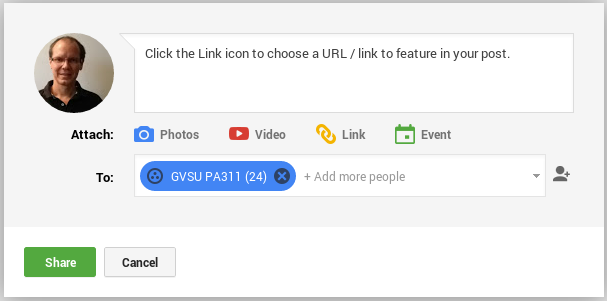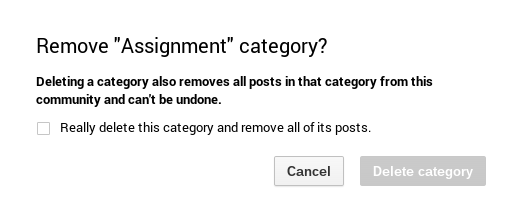How To Create Google Community
Here are seven tips Andy Wolber wished he shared with Google+ Community members before they started using it.
Last week, I covered how to create a Google+ Community and invite members. Public Google+ Communities provide a way to connect with people who share your interests. These communities can scale to support thousands of members. For example, there's a Community of more than 6,700 Chromebook fans talking about all aspects of various Chromebooks. A Mobile Devices Community started by Guy Kawasaki consists of more than 14,000 members sharing mobile device facts and opinions. Google+ Communities can operate at a large scale.
A Google+ Community may also be kept private, which limits discussions and visibility to Community members. Private Google+ Communities work well for company teams or private groups. I used a private Google+ Community for a college class I taught this year. Follow my instructions from last week to set up a private Google+ Community.
Here are seven tips I wish I'd shared with my Community members when we started using our Google+ Community.

Google Weekly Newsletter
Learn how to get the most out of Google Docs, Google Cloud Platform, Google Apps, Chrome OS, and all the other Google products used in business environments. Delivered Fridays
Sign up today

Google Weekly Newsletter
Learn how to get the most out of Google Docs, Google Cloud Platform, Google Apps, Chrome OS, and all the other Google products used in business environments. Delivered Fridays
Sign up todaySeven tips
1. Share posts privately to the Community
Make sure to share posts to your private Community, not the Public. Public posts won't be visible in the Community; only posts shared to the Community will be visible to the Community. (If a user accidentally posts to "Public" instead of the Community, the post may be visible on the user's profile page, but not in the Community.)
Choose your Google+ Community to share information to when posting
2. Put your featured link in the right place
Choose one of the "Attach:" options if you want to feature linked content in a post. Featured content will display at the bottom of the post.
I clicked the URL/link icon and pasted the following link: http://news.cnet.com/8301-17852_3-57581169-71/googles-schmidt-to-colbert-i-dont-understand-the-internet. Instead of displaying as a text link, as it does here, the link shows up as it does in the illustration: as a nice headline with a graphic automatically pulled from the story. You may include several links in the body of your post, but you're limited to one featured piece of content.
Google+ posts highlight one link per post
3. Check your sharing settings for Docs, Sheets and Presentations
You can, of course, share links to any of your Google docs, spreadsheets or presentations using the method described above. Make sure that the sharing settings permit people in the Google+ Community to view the document, though. Many times a student would share a post to a Google presentation that wouldn't display because the presentation's Sharing Settings hadn't been adjusted. (If you're unsure which to choose, you might select "Anyone with the link" to enable Community members to view shared documents.)
Choose Sharing Settings that enable your Community members to view shared Google docs
4. Classify content with Categories
Categories provide a way to classify posts. For example, the Chromebooks Community has a category for each major manufacturer of Chromebooks (e.g., Samsung, Acer, etc.), as well as functional categories, such as "Breaking News", "Tips and Tutorials", "Rumor Discussion".
As a group owner, create Categories by choosing the sprocket icon for your Community, then choose "Edit Community". Choose "Add category...", then edit your categories.
Choose the sprocket to edit your Community, then...
Add categories, as needed.
New posts to the Community will display the option for users to post to a specific category.
Users can choose a category for new posts
IMPORTANT: Should you choose to delete a Category, all posts within that Category will also be deleted. Choose your categories wisely.
WARNING: Deleting a Community category also removes all posts within the category!
5. Simplify search with hashtags
Google+ supports the use of hashtags. At Google I/O 2013, Googlers announced that Google+ will automatically attempt to generate hashtags for posts, based on the post content. For example, a post about the San Francisco Giants' catcher might be dynamically tagged #BusterPosey. Users can still add hashtags within posts. For tech users, tags of #storage #hardware #drives might be relevant in a post about solid state drive storage costs.
Use hashtags to simplify searches for related content
6. Engage: +1, Comment, and Reply
Make sure your Community members know the basics, which are that:
- a +1 "votes up" a post, comment or reply,
- a Comment to a post displays below the original post, and
- a Reply inserts the name of the person to which you are replying at the beginning of a response.
7. Hangout with your Community
Once you've mastered the basics above, try a live Hangout with your private Google+ Community. Go to your Community's main page, then click Hangout to start a live video meeting over the web that anyone in the Community can join. A Community Hangout can be a fast way for a team to work through critical issues in real time.
Start a Hangout with your Community to meet with Community members via webcam
So there you have it: seven tips to spur your Community members toward successful participation in your Community. Please join the TechRepublic community and share your tip for Google+ Community success in the comments below. I look forward to reading your comments and replies.
Also read
- Quick Tip: Set up a Google+ Community
- Google Apps for idea management
- Pimp your Google Sites for better collaboration
How To Create Google Community
Source: https://www.techrepublic.com/blog/google-in-the-enterprise/seven-tips-for-using-google-plus-community-features/
Posted by: suttonyoughtley.blogspot.com










0 Response to "How To Create Google Community"
Post a Comment